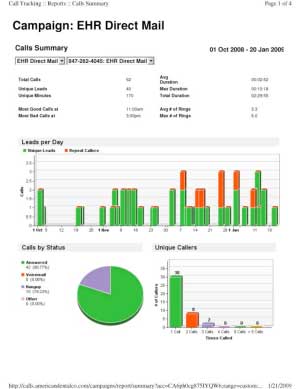Marketing Insider: Have a plan
Example of direct mail campaign tracking program There are many elements to a marketing plan you can track with TTN (tracking telephone numbers). Here’s a sample marketing plan and how you can track the results.


Example of direct mail campaign tracking program
There are many elements to a marketing plan you can track with TTN (tracking telephone numbers). Here’s a sample marketing plan and how you can track the results.
Plan Component
Twice monthly placements in a local newspaper: if you only run one ad, acquiring an additional Tracking Telephone Number should be sufficient to gather the necessary data.
Direct mail to current and new residents as well as direct mail to area employees. Because the practice is deploying two distinct direct mail tactics, it’s important to distinguish between the responses. Acquire at least two tracking telephone numbers, one for each strategy. You may also want to acquire more than two TTNs for ‘a/b testing,’ which involves changing a variable, such as the headline, to see if there is any significant difference in response.
A Web site, including paid and organic Web marketing. Your Web site should have a TTN prominently displayed near the top of each page. It should be in text, not graphics, format. This helps search engine robots (bots) identify yours as a local business which, in turn, helps you rank higher when Web surfers are looking for a dentist in your area.
If you are invested in SEO (search engine optimization) and PPC (pay per click) strategies, consider using JavaScript rewrites. These permit a different TTN to appear on your Web site as a function of how the visitor got there. For example, if people use Google to find you, they’ll see one TTN. If they use Yahoo they’ll see a different TTN. If you use a drip marketing campaign that is intended to communicate with prospective patient leads who’ve visited your Web site and have signed up to receive your communications, you’ll also want to track these captures. This can be done by using an online tracking portal.
Be sure some form of analytics is included with your Web site, and that you have access to and are familiar with its use. Most Web hosting services include an analytics service, so you should be able to ascertain detailed information about who is clicking through, when, from where, and through what pages. This feedback is indispensable in learning what visitors find interesting as well as what they do not, which in turn permits you to make improvements to your Web site and Web-based marketing.
Automated email-based communications with patients of record (what we call Patmetrics©). Tracking the benefit of your internal marketing efforts can also be enhanced by using TTNs. But because you already know who these people are, you may or may not care about tracking to that degree. For instance, if you measure average patient production (by dividing total production for the year just ended by the number of active patients) just before you implement your new tactic, then perform the same measurement one year hence, any increase in average patient production will at least be partly attributable to the new tactic. Because the cost to implement such strategies is usually relatively low, any increase should justify continuing the tactic.
If you want to be more precise, calculate response rate by assigning a unique landing page containing your “Special Patients Only” offer, then monitoring the number of click-throughs to the landing page, and dividing that number by the number of patients contacted. To calculate your closing ratio, or how many patients accepted the offer, divide the number of patients who paid for the offer by the total number contacted.An annual cause-related event. Cause-related marketing continues to be one of dentistry’s least used practice building tactics (see Marketing Insider: Cause Related Event Marketing). Tracking the efficacy can be easily accomplished by setting up a unique event registration page for your event* and having the link to the Registration page placed on your practice’s home page. Following the event, compare who on the attendee list (who is not already a patient) becomes a patient. Be aware, however, that as with all marketing tactics, there may be a considerable time lag between the exposure and the response.
*Event Registration and Fund Raising Pages are offered free to ClimbForACause.org participants, courtesy of American Dental Marketing. Alternatively, you can dedicate a landing page on your Web site exclusively for this purpose.